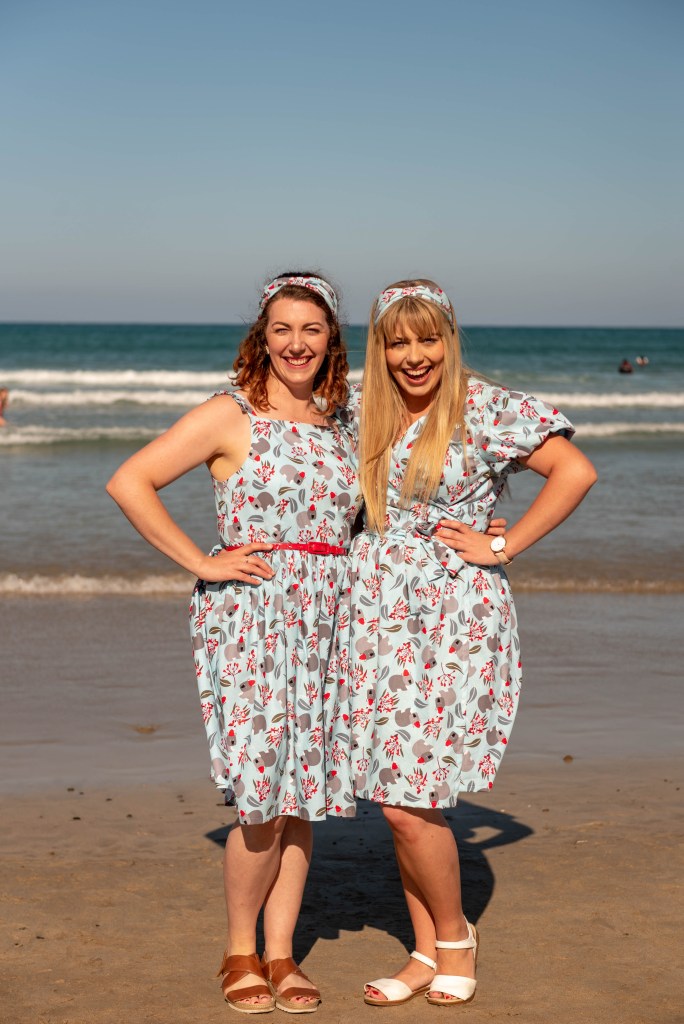When we helped Schultz Apparel test the Senna Dress we were in a lockdown away from our normal machines so we took on the challenge of stitching the dress in a different way. We would normally use our industrial sewing machine or electric domestic Bernina machine then finish our seams using an overlocker. None of this was an option so we scouted our parent’s house to see what we could find.
Senna Dress
The Senna dress is fitted around the bust and loose at the waist. It features a pleated skirt and tie at the center back and waist.
This is a simple beginner-friendly pattern with no fastening just the self-made ties.
Vintage Singer Sewing Machine

We found our Nan’s old Vintage Singer Sewing Machine which is a 306K Model, it has an electric foot pedal and is still working. This was Nan’s first electric sewing machine which would have been purchased in Echuca around 1956 when our grandparents lived in Gunbower. It has made many dresses for our family as has many machines since but this one is lucky enough to still be with us.
In terms of using the machine, it takes some work to get it moving and sometimes required to hand roll the wheel for the first stitch but once moving it stitched really well. The reserve as expected on a machine of this age is a manual leaver which needed to be moved to the reverse position and then back to the forward stitch length position.
Once we had tested the sewing machine worked our next challenge was deciding how to finish the seams. There were a few options including making bias from old sheets but we chose to go with pinking shears which seem appropriate considering the machine we were also using.
Pinking Shears



Before overlockers were available for the domestic market home sewers had to use alternative methods to finish the inside of their garments. Having said this, an overlocker is not essential to have. If you are just starting sewing it can be a large cost and you should not feel the pressure to purchase one, you can find many other ways to finish your seams including bias, zigzag or pinking shears.
Pinking sheers look like a heavier pair of scissors with a sawtoothed instead of straight blades and cut the fabric to have a zigzag edge. This prevents the woven fabric from fraying with the short diagonal cuts of the zigzag that do not provide any long fibres on the edge to get caught or damage and pull their full length. There are few seams in the Senna Dress




Using the selvedge

As we needed the full width of our cotton fabric for the skirt pieces we were to cut across the width of the fabric and we used the already existing selvedges as the finish for our seams. Cheating? Maybe but also using the resources we had on hand, it is an already finished seam and it did not affect the overall finish of the dress
Double Rolled Hem

For the hem of the dress, we created a wide double rolled hem, pressing the material over 1cm and then 4cm. We were able to have such a deep hem because the overall shape of the skirt piece is rectangular meaning that we could work on the straight grain of the fabric.
Finished Zebra Stripes


The Senna dress is simple garment to construct the instructions provided by Schultz Apparel are clever and could be described as the path of least resistant show by the order the all in one neck facing is finished around the neck and armholes. Always winning points with us the instuctions include understanding in all the good places.
With no fastenings required is a great pattern for beginner sewers to create yourself an easy to wear Summer number.

Photography Notes
Photographer: Erin Ritchie
Model: Lauren Ritchie
Dress Pattern: Senna Dress by Schultz Apparel

Other Schultz Apparel patterns we have made include Ottlia Top, Begonia Dress and Minna Dress.




















































































































